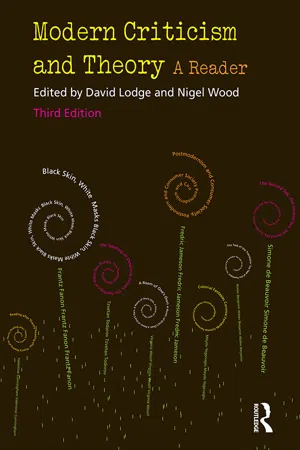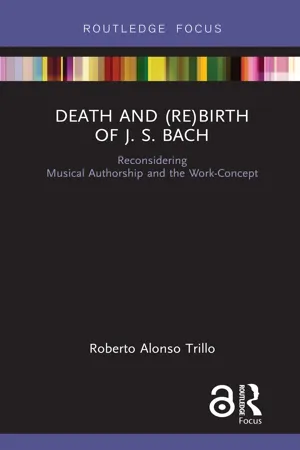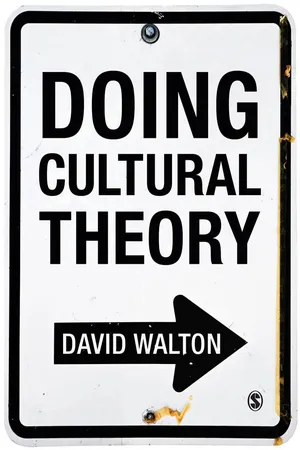Literature
Roland Barthes
Roland Barthes was a French literary theorist and philosopher known for his influential works on semiotics, structuralism, and literary criticism. He is renowned for his concept of "the death of the author," which argues that the author's intentions are not the sole determining factor in interpreting a text. Barthes' ideas have had a profound impact on literary theory and cultural studies.
Written by Perlego with AI-assistance
Related key terms
8 Key excerpts on "Roland Barthes"
- eBook - ePub
- Murray Pomerance, R. Barton Palmer(Authors)
- 2015(Publication Date)
- Rutgers University Press(Publisher)
10 Roland Barthes What Films Show Us and What They Mean WILLIAM BROWNRoland Barthes’s method of structural analysis, as well as his concepts of the readerly and the writerly text, the death of the author, and the punctum , are relevant to and have at times been taken up by film studies (see, for example, Pomerance 107ff). However, in this essay I am going to elaborate upon Barthes’s slightly overlooked distinction between denotation and connotation to demonstrate how, when we watch films, we often unthinkingly conflate what we actually see with what it supposedly means. To do this, I shall look at moments from two films, Sofia Coppola’s Marie Antoinette (2006) and Joseph L. Mankiewicz’s Guys and Dolls (1955), arguing that precise explanations that elaborate how we get from what we see to how we understand it are the foundation of good film scholarship.Barthes: Key IdeasRoland Barthes (1915–1980) was a prolific thinker and writer who authored some twenty books between the late 1950s and 1980, when he was killed in a traffic accident in Paris. Various texts have also been published posthumously. One of his first major publications was Mythologies , which remains one of his best known works today. In Mythologies , Barthes dissects aspects of popular culture, in particular advertisements, in order to show how in order to sell products advertisers draw upon not truths but myths. Barthes analyzed the way images often function not simply in a neutral fashion but as signs with meanings above and beyond what we actually see. For this reason, Barthes is associated with the study of signs, or what is often referred to as semiotics.Barthes is also associated with structuralism and, latterly, poststructuralism. In a series of works on literature, starting with Writing Degree Zero and culminating perhaps in S/Z , his analysis of Honoré de Balzac’s novella Sarrasine - eBook - ePub
Modern Criticism and Theory
A Reader
- Nigel Wood, David Lodge(Authors)
- 2014(Publication Date)
- Routledge(Publisher)
17 Roland Barthes
DOI: 10.4324/9781315835488-17Introductory note
Roland Barthes (1915–80) was the most brilliant and influential of the generation of literary critics who came to prominence in France in the 1960s. After a slow start to his academic career (due mainly to illness), Barthes became a teacher at the Ecole Pratique des Hautes Etudes in Paris, and at the time of his death was Professor of Literary Semiology (a title of his own choice) at the prestigious Collège de France. His first book, Writing Degree Zero (1953; English translation 1972) was a polemical essay on the history of French literary style, in which the influence of Jean-Paul Sartre is perceptible. Mythologies (1957; translated 1973), perhaps Barthes’ most accessible work, wittily analysed various manifestations of popular and high culture at the expense of bourgeois ‘common sense’. A controversy with a traditionalist Sorbonne professor, Raymond Picard, in the mid-1960s, made Barthes famous, or notorious, as the leading iconoclast of ‘la nouvelle critique’. This movement, a rather loose alliance of critics opposed to traditional academic criticism and literary history, drew some of its inspiration from the experiments of the nouveau roman (see Alain Robbe-Grillet, ‘A Future for the Novel’, section 3 4 in 20th Century Literary Criticism), and in the late 60s and early 70s was associated with radical left-wing politics (especially in the journal Tel Quel – see Introductory note on Julia Kristeva, below p. 348); but methodologically it depended heavily on structuralist semiotics in the tradition of Saussure and Jakobson.Barthes himself produced an austere treatise on The Elements of Semiology in 1964 (translated 1967) and an influential essay entitled ‘Introduction to the Structural Analysis of Narrative’ in 1966 (included in Image-Music-Text - eBook - ePub
Death and (Re) Birth of J.S. Bach
Reconsidering Musical Authorship and the Work-Concept
- Roberto Alonso Trillo(Author)
- 2018(Publication Date)
- Routledge(Publisher)
Barthes favored readings of the text that opposed the former focus on objective analysis and explored instead anarchical approaches, based in linguistics, psychoanalysis, and anthropology. Since Barthes viewed the author’s intention as an undue constraint on the reader’s freedom, he proposed that, given the inaccessibility of an original master meaning or intention, “the birth of the reader must be at the cost of the death of the Author” (Barthes 1977: 148). This idea provides a powerful framework to understand the questioning of the dominant notion of authorship posited by the… Bach … project. It is in this light that music, as literature, can be understood as the quagmire where all identity, including that of the body that writes, is lost. Following the previous argument, Barthes defined the figure of the author as a modern notion, “a product of our society insofar as, emerging from at the end of the Middle Ages with English empiricism, French rationalism and the personal faith of the Reformation, it discovered the prestige of the individual” (Ibid.: 142–143). Consequently, the modern author-concept, as that of the closed work, cannot be conceived as a given but as a historically determined and evolving regulative idea, one that parallels Goehr’s “historicist” reading. This historical shaping has led to an image of literature in contemporary culture that “is tyrannically centered on the author, his person, his history, his tastes, his passions” (Ibid.: 143). From Barthes’s perspective, the text cannot be seen as a “line of words, releasing a single ‘theological’ meaning (the ‘message’ of the Author-God) but a multidimensional space in which a variety of writings, none of them original, blend and clash. The text is a tissue of citations, resulting from the innumerable centers [ sources ] of culture” (Ibid.: 146). The writer thus imitates a gesture forever anterior, never original - eBook - ePub
- Andrew Bennett(Author)
- 2004(Publication Date)
- Routledge(Publisher)
But for Barthes the consequences of this recognition of the author’s absence in principle are wide-ranging, and much is at stake in his essay, in Barthes’s declaration of radical textuality, of texts working independently of their authors. Barthes raises fundamental questions of literary interpretation and ‘appreciation’; he interrogates the nature of literary speech acts and of literary-critical judgements; he attempts to reconfigure our understanding of how texts work; he subverts long-held beliefs concerning the priority of the human, of individuality, of subjectivity and subjective experience; and he challenges conventional notions of biography and autobiography as well as traditional conceptions of the institution of literature and the nature and status of the literary work. In this chapter, I will try to account for the importance and significance of Barthes’s essay before moving on to consider Michel Foucault’s influential response to and development of his position in ‘What is an Author?’, an essay that may be said to re-open literary theory to questions of authorship and open authorship to the question of history. Barthes’s and Foucault’s essays constitute the founding statements of much subsequent critical and theoretical work on the author: almost forty years later we are still caught up in debates about the problem of authorship instigated by Barthes and Foucault in the late 1960s.WHO SPEAKS?
Properly to assess Barthes’s argument about the author one would in fact need to engage not just with a single title or even a single essay but with at least three overlapping essays from the late 1960s and early 1970s – ‘The Death of the Author’ itself, ‘From Work to Text’ (1971) and ‘Theory of the Text’ (1973) – as well as with a number of Barthes’s books, including S/Z (1970) and The Pleasure of the Text - eBook - ePub
Barthes
A Biography
- Tiphaine Samoyault, Andrew Brown(Authors)
- 2017(Publication Date)
- Polity(Publisher)
11LiteratureThe celebrated distinction that Barthes drew in 1960, in the review Arguments, between ‘écrivains’ and ‘écrivants’ provided him with the framework for a twofold view of language. Public language of the latter transmitted ideas about the world – the language of academia, politics and research. And the tautological language of the former ‘absorbs the world’s why in a how to write’:1 the language of literature. But it was the hybrid figure resulting from a mixture of the two that defined the position Barthes wanted to occupy: ‘Everyone today moves more or less openly between the two postulations, the author’s and the writer’s; it is doubtless the responsibility of history which has brought us into the world too late to be complacent authors and too soon (?) to be heeded writers.’2 This definition of the intellectual he felt himself to be at the start of the 1960s, when he showed himself to be aware of the place he occupied in history, also demonstrates that, even while focusing intensely on research of an academic kind, Barthes never abandoned literature, as a corpus, a production and a project: literature continued to frame his work in sociology and semiology. While his path took him from science to literature, his main endeavour was to think of language in all its forms.The deliberate and productive quest for methods on which Barthes embarked between 1958 and 1966 can be subsumed under the idea of interpretation – especially the close reading of texts, which Barthes tried out on different types of language: advertising, fashion writing, cinema and literature. To do so, he had to transform and renew old styles of interpretation. An article with the title ‘Oeuvres de masse et explication de texte’ (‘Mass culture and textual interpretation’) that he published in issue 2 of Communications, in March 1963, shows the interest of the method as a critique of language, but suggested that it needed to be modified in order to get a handle on a certain number of contemporary objects (commercial cinema, the hit parade, the photo-novel) that might not be properly understood if the usual rules of interpretation were applied to them: ‘We will, for example, need to revise critical notions such as that of originality. We will also need to accept the notion of aesthetic “relevance”, i.e. a formal logic within a great collective structure, even if the latter is extremely “commercial”.’3 This critique enables us to analyse the major articles of mass consumption as languages (in the surveys that he carried out for Publicis, for instance), but also to read literature in a new way. So these were also the years in which Barthes formed his very powerful theory of the text, as evidenced in Critical Essays and On Racine, where he set out the broad lines that would lead to his great texts on reading as a model of freedom and creativity, S/Z and The Pleasure of the Text - eBook - ePub
- David Walton(Author)
- 2012(Publication Date)
- SAGE Publications Ltd(Publisher)
The questioning of this disinterested view promised by so-called objective science has become very important to what have become poststructuralist approaches. In fact, Barthes stated that he did not agree with the belief that there is the objectivity of the scientist, on the one hand, and the limited subjectivity of the writer, on the other. He lived the contradiction of the two (11), able, in the same book, to write in terms of ‘objective analysis’ and admit that ‘form is always there to outdistance the meaning’ (122). This introduces an element of, to use something of a clichéd term, ‘slippage’ into what may have seemed an effort to fix meaning through semiological analysis. It is this consciousness of having to live with theoretical contradictions that could be said to characterize the deconstructive thinking of Jacques Derrida and poststructuralist thinking in general. Readers as writers, the death of the author and ‘authoricide’ Barthes’ essay entitled ‘The Death of the Author’ is also very useful in terms of introducing themes which echo motifs found in deconstructive thinking. This is because of what the essay has to tell us about the relations between authors, interpretation and the (de)stabilization of meanings. In this essay Barthes makes the point that the figure of the author is a modern phenomenon arising from around the time of the Middle Ages, insofar as in pre-modern societies (what he calls ‘ethnographic societies’) stories were recounted by mediators. Barthes stresses that in the Middle Ages emphasis was placed more on the skill of the narrator rather than on the ‘author’ as ‘genius’ - eBook - ePub
The Poverty of Structuralism
Literature and Structuralist Theory
- Leonard Jackson(Author)
- 2014(Publication Date)
- Routledge(Publisher)
jouissance (orgasmic release, bliss). This seems (still working on the same assumptions) to have been Barthes’ psychic reward for his adventurous escape from his structuralist phase.4.2 Philosophical logic and semiological structuresTo return to 1964: Elements of Semiology is a simple handbook of Saussurean ideas that might be useful for the aspirant semiologist. I have already discussed most of these. There are two general points worth commenting on, that arise both in this book and The Language of Fashion . The first is that Barthes has some major logical problems, which arise directly from the logical poverty of the Saussurean model he is using. The only sign-relation Saussure recognizes is the arbitrary relationship of signifier and signified to form a sign. In the analysis of something logically quite complicated like the language of fashion magazines, we are actually dealing with many different kinds of meaning relationship between linguistic expressions, non-linguistic signifying units, and non-linguistic non-signifying items. Barthes has to map all of these onto sign-relationship – sometimes by claiming that a whole sign at one level acts as a signifier at a higher level.Obviously, he does not always succeed in this reduction. What is needed is a theory that admits the full complexity of meaning – relationships – a theory that will, for example, distinguish between (1) the function of phonemes in distinguishing between one word and another; (2) the Saussurean sign-relation between a word and a concept; (3) the Fregean distinction between sense and reference; (4) standard philosophical distinctions between assertion, implication, presupposition, etc. and (5) a host of others. One can’t map all these onto the Saussurean sign. Barthes is acutely aware of most of them, but lacks, and cannot himself construct, an adequate formal theory. - eBook - ePub
History and Imperialism
Writings, 1963-1986
- Louis Althusser, G. M. Goshgarian(Authors)
- 2020(Publication Date)
- Polity(Publisher)
The structure is in the work. So reading structures, bringing out the work’s structures, is practically a reading of the aesthetic as such: the aesthetic is now no longer an ideology of the transcendence of the beautiful with regard to the work of art. It’s a reading of the immanence of the structures of the beautiful, of the aesthetic structures in the work itself. This is very important, because it’s what distinguishes [Barthes] from a structuralism that calls itself structuralism, but is in fact just one of the by-products of the classic aesthetic tradition. I think that that’s what Barthes is, to a great extent. There are other things in him, but, finally, that’s what it comes down to. That’s the side he leans towards, that’s where he lands, where he’s going to land. On the one hand – although there’s another form of structuralism, but one presupposing, precisely, all the questions that all these currents fail to put to the work of art itself. Optional Visibility: Roland Barthes and Jean-Pierre Richard Take a fellow like Richard: I’m talking to you about him on the basis of what I know about him. A fellow like Richard also assumes the work of art to be aesthetic. He doesn’t ask what allows us to say that it’s an aesthetic work. That’s the fundamental question. Richard makes an inventory of the work’s themes [ thématique ]. In his way, he studies a certain structure of the work, but not a structure in Barthes’s sense: a system of signifiers, each of which is implied by the others, which refer one to the other and so on, forming a closed system, the very opening of which has a prior closure as its condition of possibility. In Richard, it’s a question of bringing out themes that it’s a question of discovering through variations. The work of art is conceived of as a kind of symphony, which is itself conceived of as the elaboration of a whole series of basic themes that run through the work, both when they’re visible and also when they’re hidden
Learn about this page
Index pages curate the most relevant extracts from our library of academic textbooks. They’ve been created using an in-house natural language model (NLM), each adding context and meaning to key research topics.







